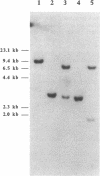Abstract
Azotobacter vinelandii is a free-living nitrogen-fixing bacterium that has one of the highest respiratory rates of all aerobic organisms. Based on various physiological studies, a d-type cytochrome has been postulated to be the terminal oxidase of a vigorously respiring but apparently uncoupled branch of the electron transport system in the membranes of this organism. We cloned and characterized the structural genes of the two subunits of this oxidase. The deduced amino acid sequences of both subunits of the A. vinelandii oxidase have extensive regions of homology with those of the two subunits of the Escherichia coli cytochrome d complex. Most notably, the histidine residues proposed to be the axial ligands for the b hemes of the E. coli oxidase and an 11-amino-acid stretch proposed to be part of the ubiquinone binding site are all conserved in subunit I of the A. vinelandii oxidase. The A. vinelandii cytochrome d was expressed in a spectrally and functionally active form in the membranes of E. coli, under the control of the lac or tac promoter. The spectral features of the A. vinelandii cytochrome d expressed in E. coli are very similar to those of the E. coli cytochrome d. The expressed oxidase was active as a quinol oxidase and could reconstitute an NADH to oxygen electron transport chain.
Full text
PDF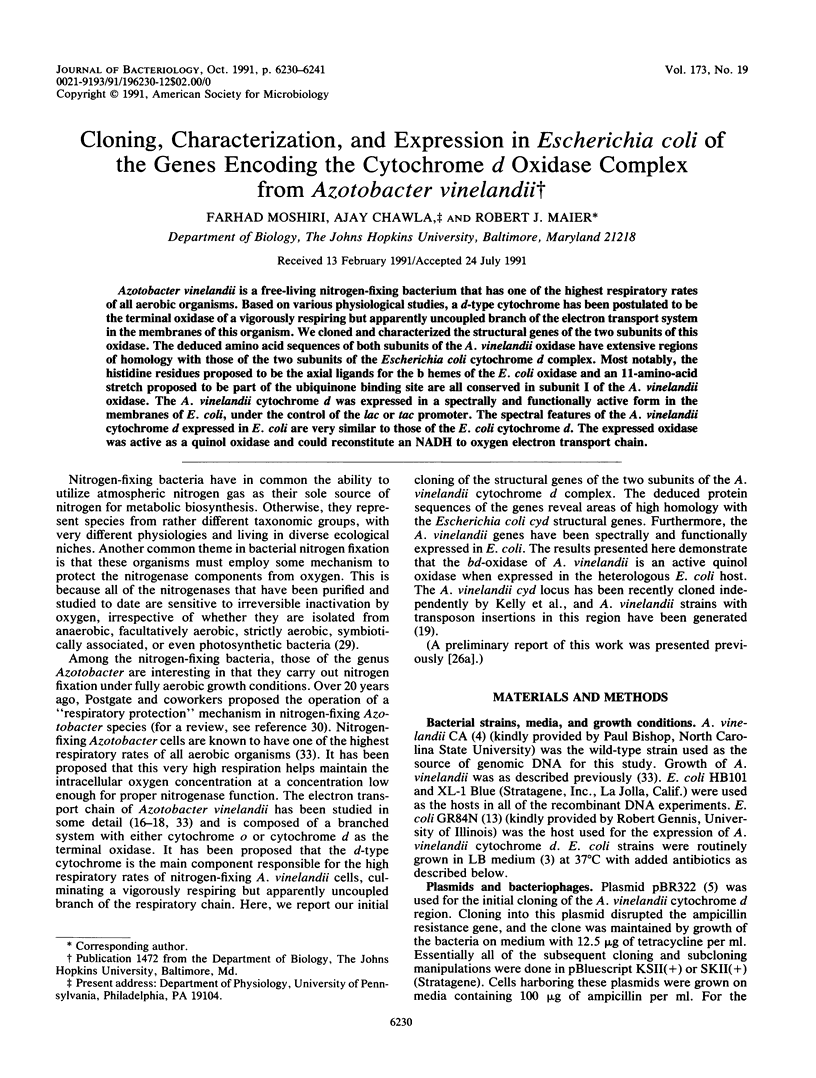
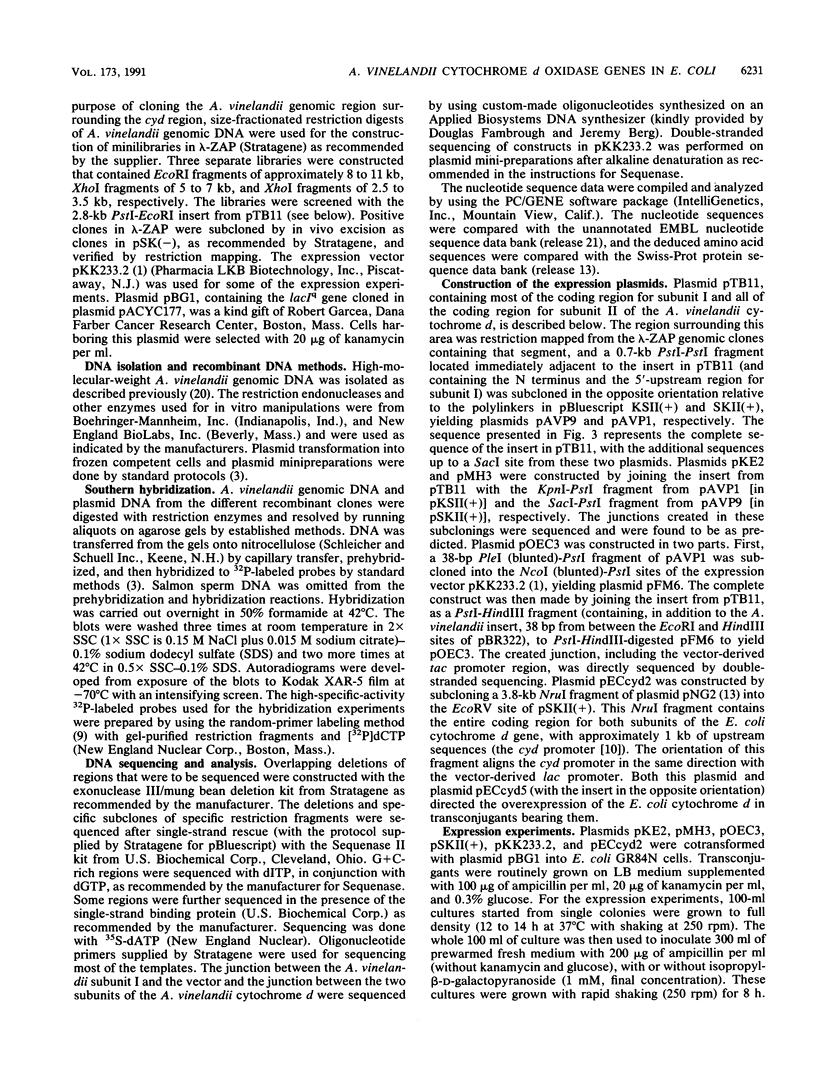
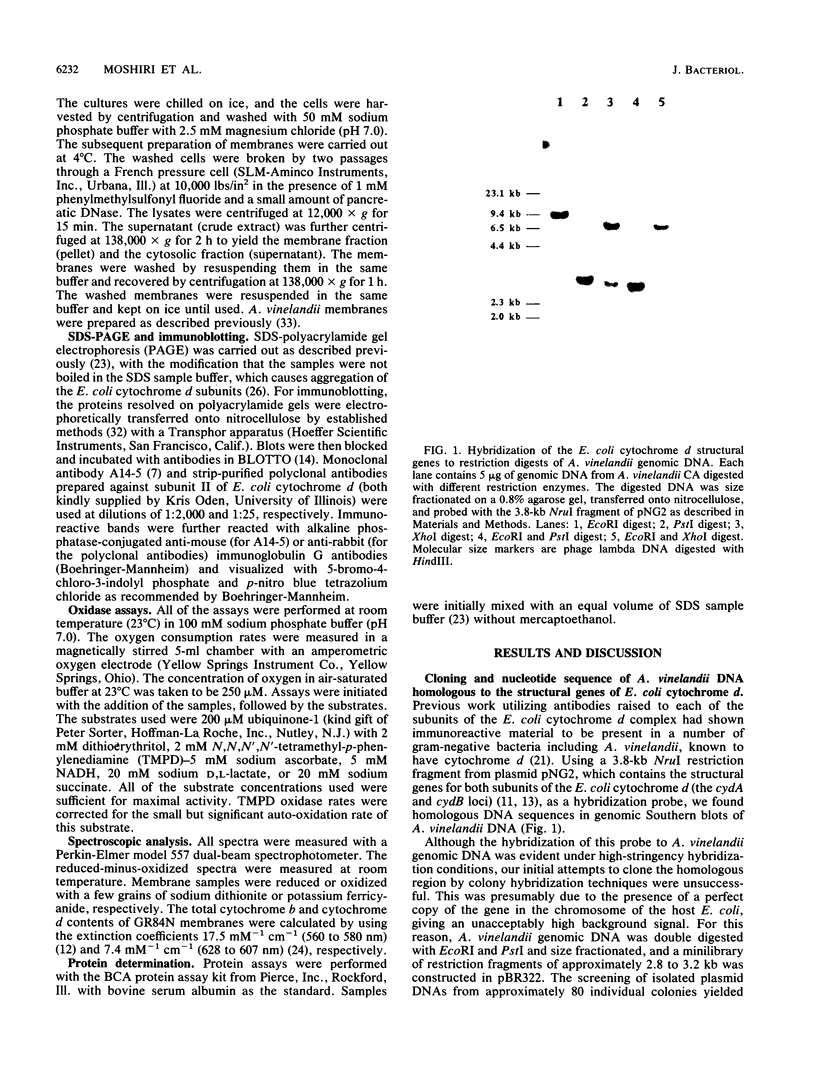
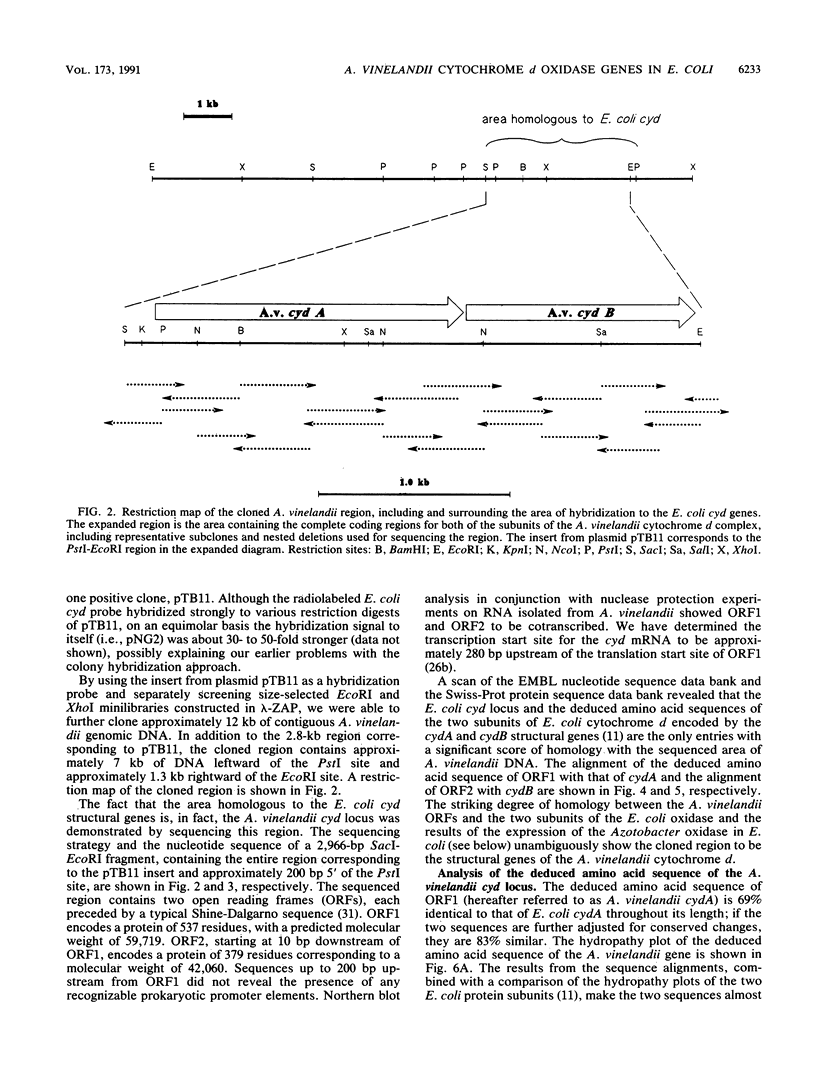
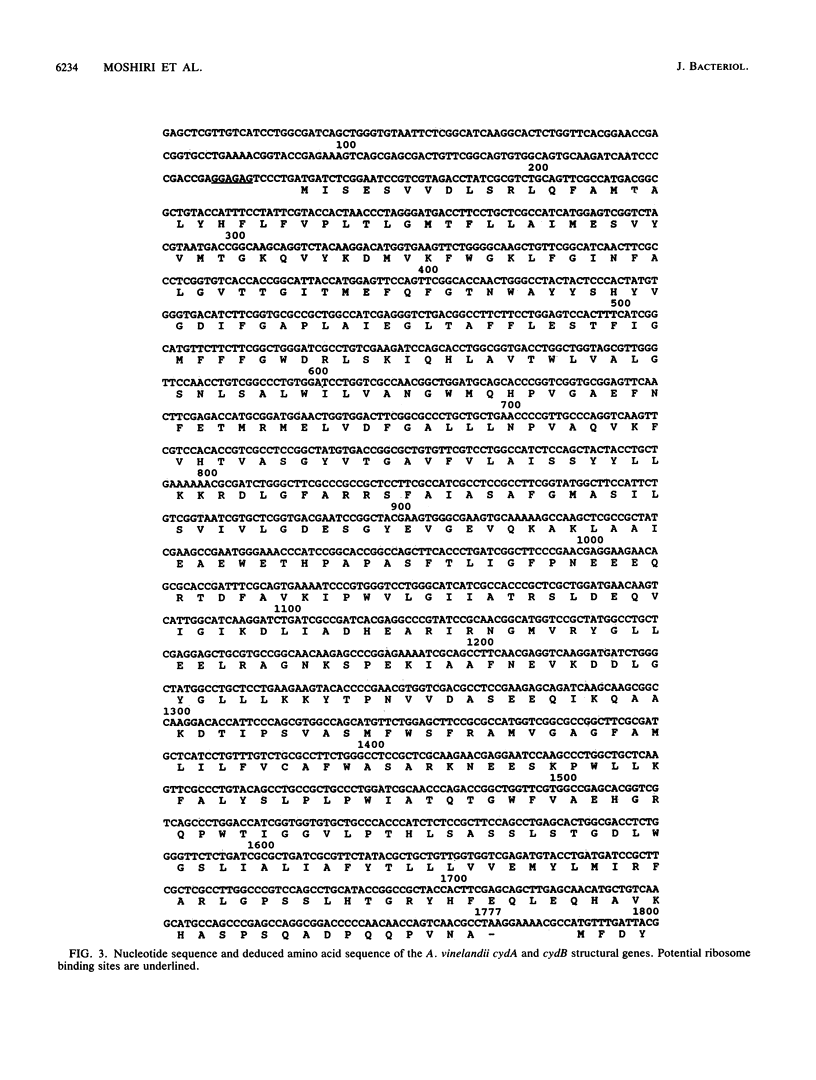
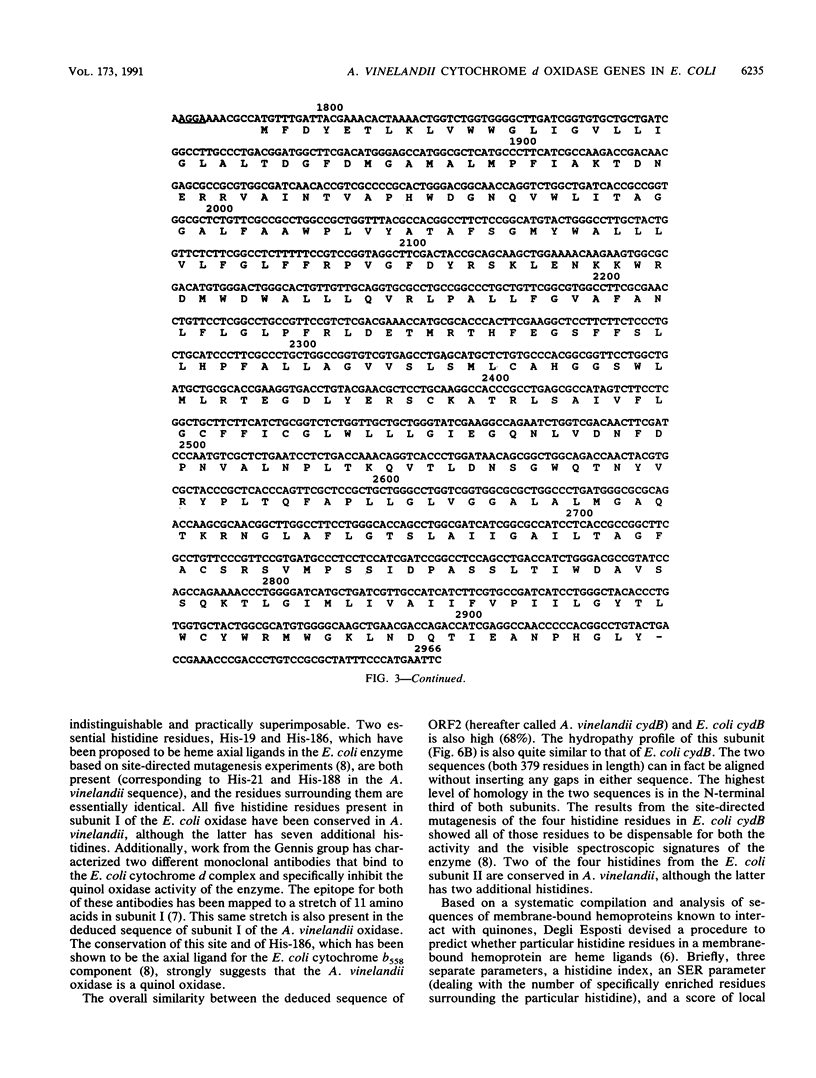
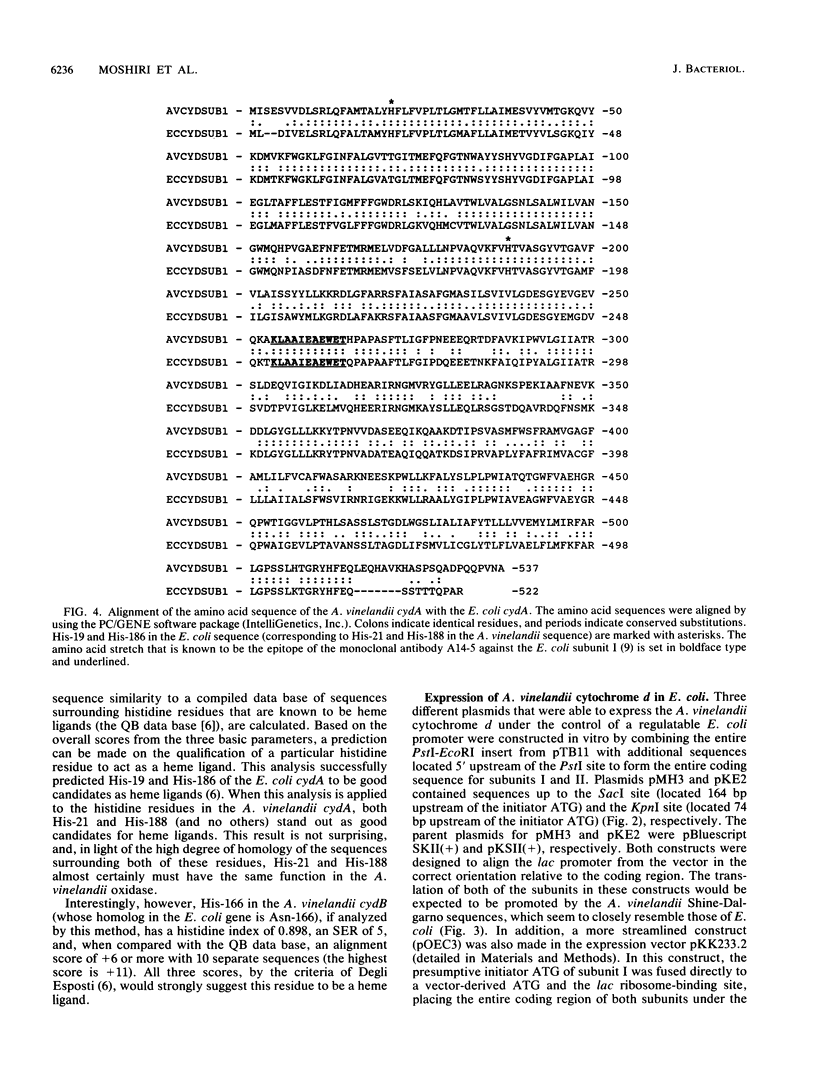
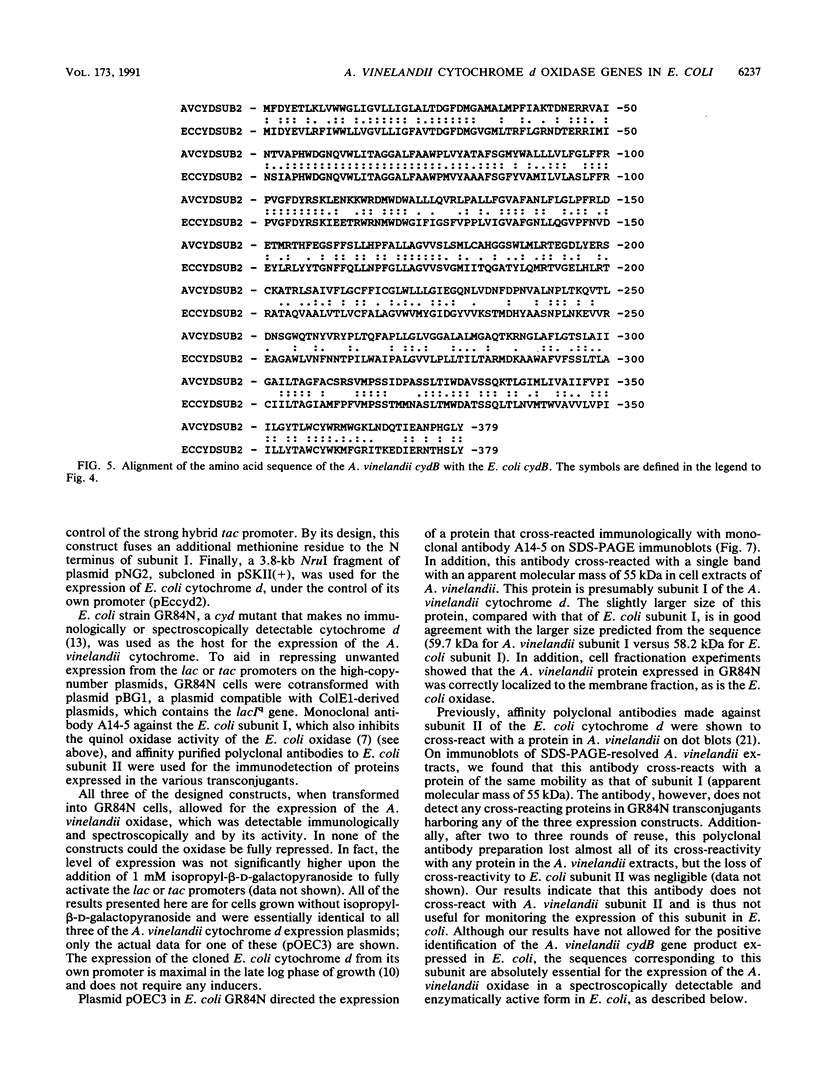
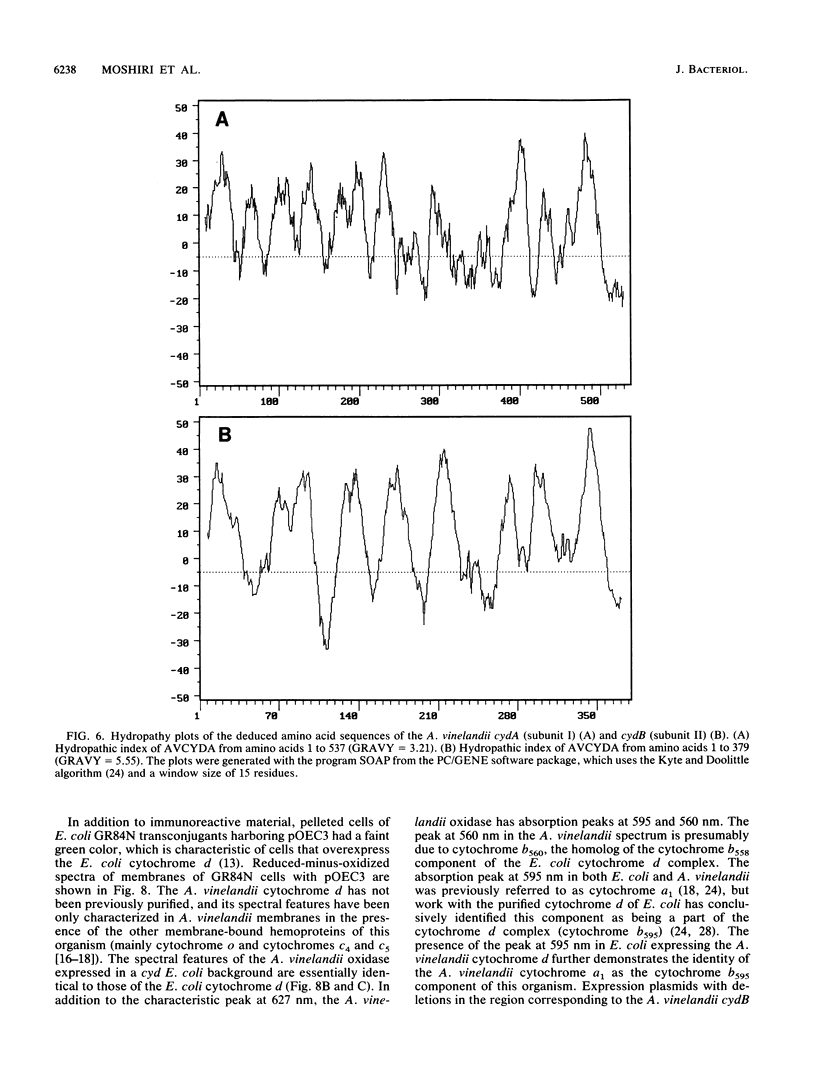
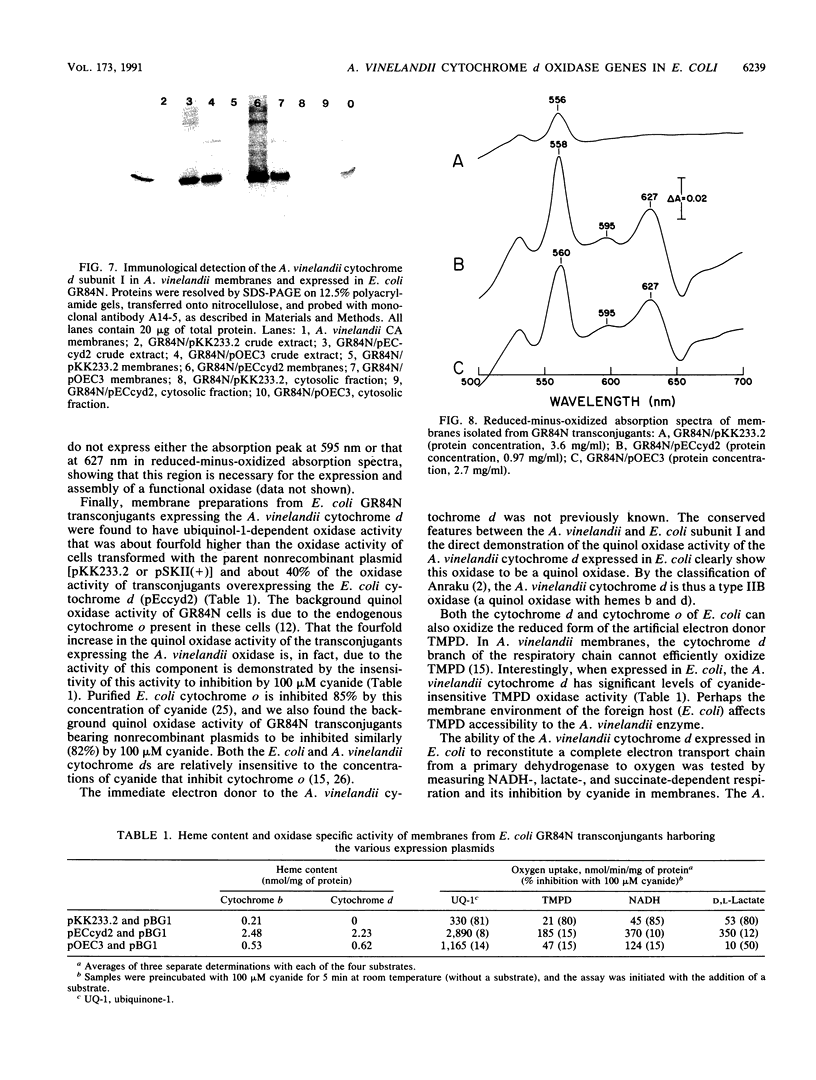
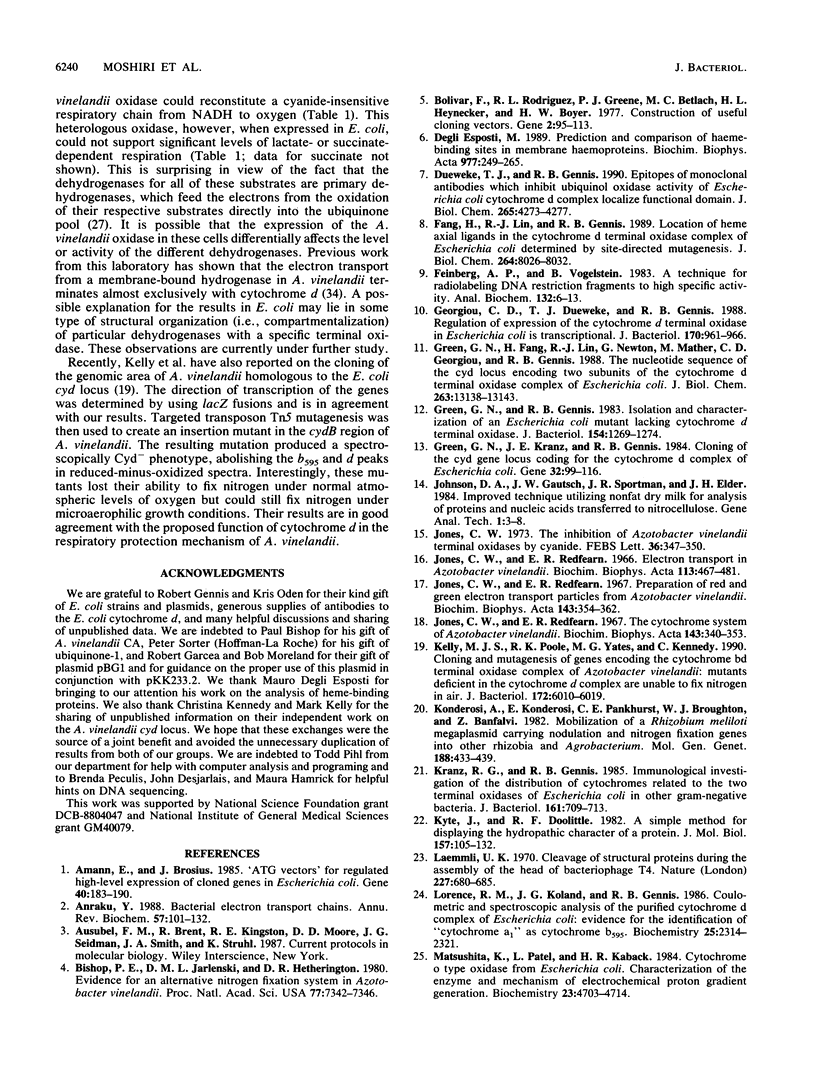
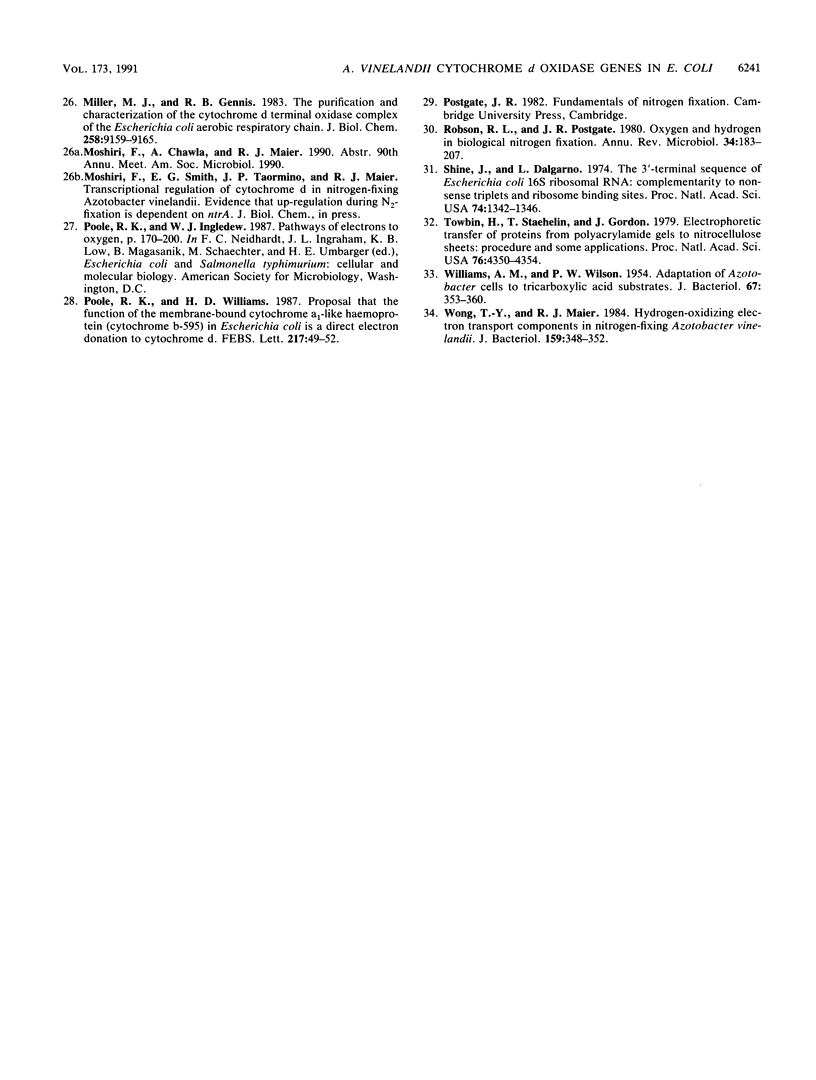
Images in this article
Selected References
These references are in PubMed. This may not be the complete list of references from this article.
- Amann E., Brosius J. "ATG vectors' for regulated high-level expression of cloned genes in Escherichia coli. Gene. 1985;40(2-3):183–190. doi: 10.1016/0378-1119(85)90041-1. [DOI] [PubMed] [Google Scholar]
- Anraku Y. Bacterial electron transport chains. Annu Rev Biochem. 1988;57:101–132. doi: 10.1146/annurev.bi.57.070188.000533. [DOI] [PubMed] [Google Scholar]
- Bishop P. E., Jarlenski D. M., Hetherington D. R. Evidence for an alternative nitrogen fixation system in Azotobacter vinelandii. Proc Natl Acad Sci U S A. 1980 Dec;77(12):7342–7346. doi: 10.1073/pnas.77.12.7342. [DOI] [PMC free article] [PubMed] [Google Scholar]
- Bolivar F., Rodriguez R. L., Greene P. J., Betlach M. C., Heyneker H. L., Boyer H. W., Crosa J. H., Falkow S. Construction and characterization of new cloning vehicles. II. A multipurpose cloning system. Gene. 1977;2(2):95–113. [PubMed] [Google Scholar]
- Dueweke T. J., Gennis R. B. Epitopes of monoclonal antibodies which inhibit ubiquinol oxidase activity of Escherichia coli cytochrome d complex localize functional domain. J Biol Chem. 1990 Mar 15;265(8):4273–4277. [PubMed] [Google Scholar]
- Esposti M. D. Prediction and comparison of the haem-binding sites in membrane haemoproteins. Biochim Biophys Acta. 1989 Dec 7;977(3):249–265. doi: 10.1016/s0005-2728(89)80079-9. [DOI] [PubMed] [Google Scholar]
- Fang H., Lin R. J., Gennis R. B. Location of heme axial ligands in the cytochrome d terminal oxidase complex of Escherichia coli determined by site-directed mutagenesis. J Biol Chem. 1989 May 15;264(14):8026–8032. [PubMed] [Google Scholar]
- Feinberg A. P., Vogelstein B. A technique for radiolabeling DNA restriction endonuclease fragments to high specific activity. Anal Biochem. 1983 Jul 1;132(1):6–13. doi: 10.1016/0003-2697(83)90418-9. [DOI] [PubMed] [Google Scholar]
- Georgiou C. D., Dueweke T. J., Gennis R. B. Regulation of expression of the cytochrome d terminal oxidase in Escherichia coli is transcriptional. J Bacteriol. 1988 Feb;170(2):961–966. doi: 10.1128/jb.170.2.961-966.1988. [DOI] [PMC free article] [PubMed] [Google Scholar]
- Green G. N., Fang H., Lin R. J., Newton G., Mather M., Georgiou C. D., Gennis R. B. The nucleotide sequence of the cyd locus encoding the two subunits of the cytochrome d terminal oxidase complex of Escherichia coli. J Biol Chem. 1988 Sep 15;263(26):13138–13143. [PubMed] [Google Scholar]
- Green G. N., Gennis R. B. Isolation and characterization of an Escherichia coli mutant lacking cytochrome d terminal oxidase. J Bacteriol. 1983 Jun;154(3):1269–1275. doi: 10.1128/jb.154.3.1269-1275.1983. [DOI] [PMC free article] [PubMed] [Google Scholar]
- Green G. N., Kranz J. E., Gennis R. B. Cloning the cyd gene locus coding for the cytochrome d complex of Escherichia coli. Gene. 1984 Dec;32(1-2):99–106. doi: 10.1016/0378-1119(84)90037-4. [DOI] [PubMed] [Google Scholar]
- Jones C. W., Redfearn E. R. Electron transport in Azotobacter vinelandii. Biochim Biophys Acta. 1966 Mar 7;113(3):467–481. doi: 10.1016/s0926-6593(66)80005-x. [DOI] [PubMed] [Google Scholar]
- Jones C. W., Redfearn E. R. Preparation of red and green electron transport particles from Azotobacter vinelandii. Biochim Biophys Acta. 1967 Sep 6;143(2):354–362. doi: 10.1016/0005-2728(67)90089-8. [DOI] [PubMed] [Google Scholar]
- Jones C. W., Redfearn E. R. The cytochrome system of Azotobacter vinelandii. Biochim Biophys Acta. 1967 Sep 6;143(2):340–353. doi: 10.1016/0005-2728(67)90088-6. [DOI] [PubMed] [Google Scholar]
- Jones C. W. The inhibition of Azotobacter vinelandii terminal oxidases by cyanide. FEBS Lett. 1973 Nov 1;36(3):347–350. doi: 10.1016/0014-5793(73)80407-7. [DOI] [PubMed] [Google Scholar]
- Kelly M. J., Poole R. K., Yates M. G., Kennedy C. Cloning and mutagenesis of genes encoding the cytochrome bd terminal oxidase complex in Azotobacter vinelandii: mutants deficient in the cytochrome d complex are unable to fix nitrogen in air. J Bacteriol. 1990 Oct;172(10):6010–6019. doi: 10.1128/jb.172.10.6010-6019.1990. [DOI] [PMC free article] [PubMed] [Google Scholar]
- Kranz R. G., Gennis R. B. Immunological investigation of the distribution of cytochromes related to the two terminal oxidases of Escherichia coli in other gram-negative bacteria. J Bacteriol. 1985 Feb;161(2):709–713. doi: 10.1128/jb.161.2.709-713.1985. [DOI] [PMC free article] [PubMed] [Google Scholar]
- Kyte J., Doolittle R. F. A simple method for displaying the hydropathic character of a protein. J Mol Biol. 1982 May 5;157(1):105–132. doi: 10.1016/0022-2836(82)90515-0. [DOI] [PubMed] [Google Scholar]
- Laemmli U. K. Cleavage of structural proteins during the assembly of the head of bacteriophage T4. Nature. 1970 Aug 15;227(5259):680–685. doi: 10.1038/227680a0. [DOI] [PubMed] [Google Scholar]
- Lorence R. M., Koland J. G., Gennis R. B. Coulometric and spectroscopic analysis of the purified cytochrome d complex of Escherichia coli: evidence for the identification of "cytochrome a1" as cytochrome b595. Biochemistry. 1986 May 6;25(9):2314–2321. doi: 10.1021/bi00357a003. [DOI] [PubMed] [Google Scholar]
- Matsushita K., Patel L., Kaback H. R. Cytochrome o type oxidase from Escherichia coli. Characterization of the enzyme and mechanism of electrochemical proton gradient generation. Biochemistry. 1984 Sep 25;23(20):4703–4714. doi: 10.1021/bi00315a028. [DOI] [PubMed] [Google Scholar]
- Miller M. J., Gennis R. B. The purification and characterization of the cytochrome d terminal oxidase complex of the Escherichia coli aerobic respiratory chain. J Biol Chem. 1983 Aug 10;258(15):9159–9165. [PubMed] [Google Scholar]
- Poole R. K., Williams H. D. Proposal that the function of the membrane-bound cytochrome a1-like haemoprotein (cytochrome b-595) in Escherichia coli is a direct electron donation to cytochrome d. FEBS Lett. 1987 Jun 8;217(1):49–52. doi: 10.1016/0014-5793(87)81240-1. [DOI] [PubMed] [Google Scholar]
- Robson R. L., Postgate J. R. Oxygen and hydrogen in biological nitrogen fixation. Annu Rev Microbiol. 1980;34:183–207. doi: 10.1146/annurev.mi.34.100180.001151. [DOI] [PubMed] [Google Scholar]
- Shine J., Dalgarno L. The 3'-terminal sequence of Escherichia coli 16S ribosomal RNA: complementarity to nonsense triplets and ribosome binding sites. Proc Natl Acad Sci U S A. 1974 Apr;71(4):1342–1346. doi: 10.1073/pnas.71.4.1342. [DOI] [PMC free article] [PubMed] [Google Scholar]
- Towbin H., Staehelin T., Gordon J. Electrophoretic transfer of proteins from polyacrylamide gels to nitrocellulose sheets: procedure and some applications. Proc Natl Acad Sci U S A. 1979 Sep;76(9):4350–4354. doi: 10.1073/pnas.76.9.4350. [DOI] [PMC free article] [PubMed] [Google Scholar]
- WILLIAMS A. M., WILSON P. W. Adaptation of Azotobacter cells to tricarboxylic acid substrates. J Bacteriol. 1954 Mar;67(3):353–360. doi: 10.1128/jb.67.3.353-360.1954. [DOI] [PMC free article] [PubMed] [Google Scholar]
- Wong T. Y., Maier R. J. Hydrogen-oxidizing electron transport components in nitrogen-fixing Azotobacter vinelandii. J Bacteriol. 1984 Jul;159(1):348–352. doi: 10.1128/jb.159.1.348-352.1984. [DOI] [PMC free article] [PubMed] [Google Scholar]



